2018 MERCEDES-BENZ CLA engine overheat
[x] Cancel search: engine overheatPage 136 of 326
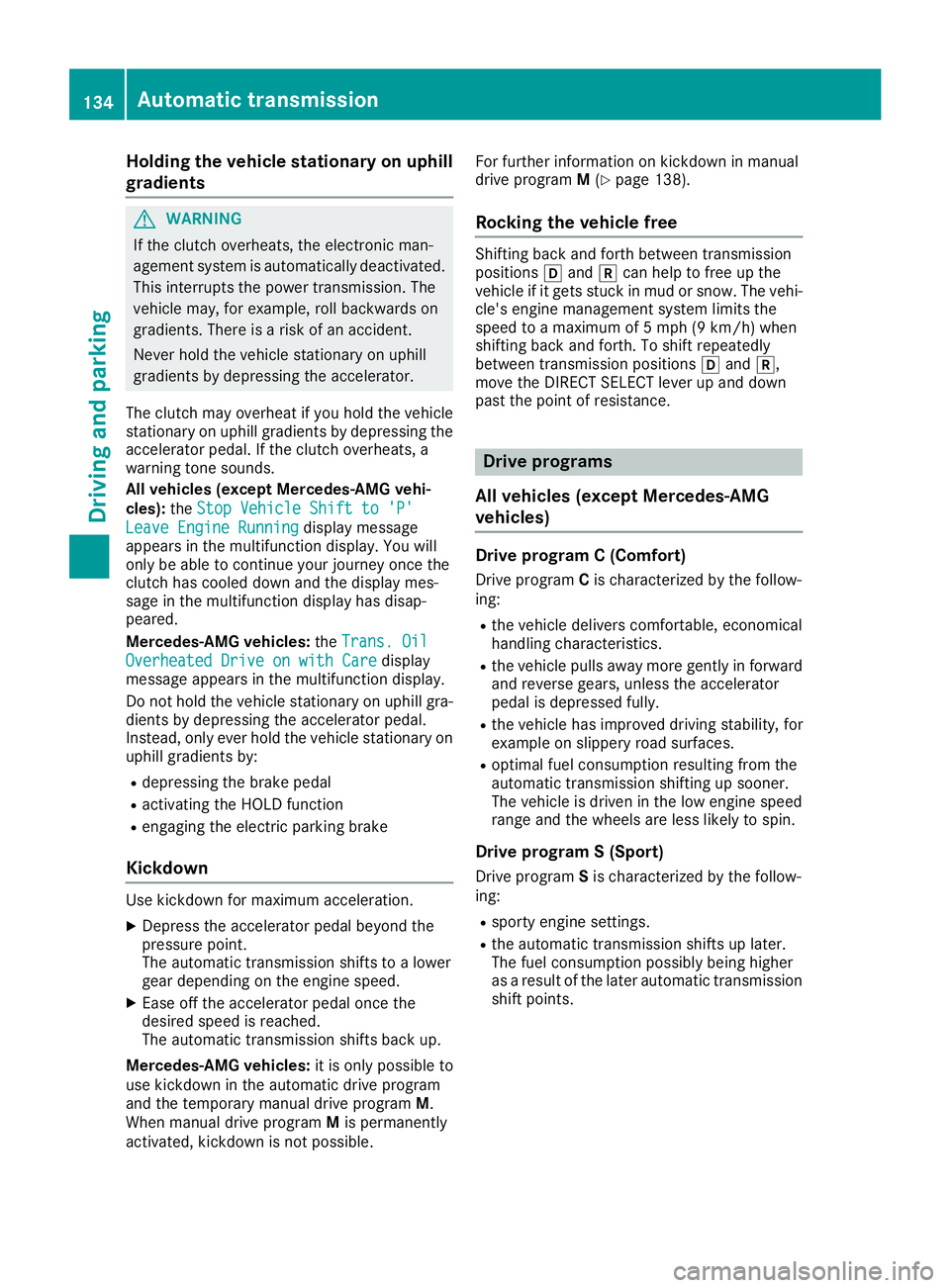
Holding the vehicle stationary on uphill
gradients
G WARNING
If the clutch overheats, the electronic man-
agement system is automatically deactivated.
This interrupts the power transmission. The
vehicl em ay ,f or example, roll backwards on
gradients. There is ar isk of an accident.
Never hold the vehicl es tationary on uphill
gradients by depressing the accelerator.
The clutch may overheat if you hold the vehicle
stationary on uphill gradients by depressing the
accelerator pedal. If the clutch overheats, a
warning tone sounds.
All vehicle s( except Mercedes-AMG vehi-
cles): the Stop Vehicle Shift to 'P'
Leave Engine Running display message
appears in the multifunction display .Y ou will
only be abl etoc ontinue you rj ourney once the
clutch has coole dd ow na nd the display mes-
sage in the multifunction display has disap-
peared.
Mercedes-AMG vehicles: the Trans. Oil
Overheated Drive on with Care display
message appears in the multifunction display.
Do not hold the vehicl es tationary on uphill gra-
dients by depressing the accelerator pedal.
Instead, only ever hold the vehicl es tationary on
uphill gradients by: R
depressing the brake pedal R
activating the HOLD function R
engaging the electric parking brake
Kickdown Use kickdown for maximu ma cceleration.X
Depress the accelerator peda lb eyond the
pressure point.
The automatic transmission shifts to al ower
gea rd epending on the engine speed.X
Ease off the accelerator peda lo nce the
desired spee disr eached.
The automatic transmission shifts back up.
Mercedes-AMG vehicles: it is only possible to
use kickdown in the automatic drive program
and the temporary manua ld rive program M .
When manua ld rive program M is permanently
activated, kickdown is not possible. For further information on kickdown in manual
drive program M ( Y
pag e1 38).
Rocking the vehicle free Shifting back and forth between transmission
positions �[ and �^ can help to free up the
vehicl eifitg ets stuck in mud or snow. The vehi-
cle's engine management system limits the
spee dtoam aximu mof5m ph (9 km/h) when
shifting back and forth. To shift repeatedly
between transmission positions �[ and �^ ,
move the DIRECT SELECT leve rupa nd down
pas tt he point of resistance.
Drive programs
Al lv ehicle s( except Mercedes-AMG
vehicles) Drive program C( Comfort)Drive program C is characterized by the follow-
ing: R
the vehicl ed elivers comfortable, economical
handling characteristics. R
the vehicl ep ulls awa ym ore gently in forward
and reverse gears, unless the accelerator
peda lisd epressed fully. R
the vehicl eh as improved driving stability ,f or
exampl eons lippery road surfaces. R
optima lf uel consumption resulting from the
automatic transmission shifting up sooner.
The vehicl eisd rive nint he low engine speed
range and the wheels are less likel ytos pin.
Drive program S( Sport)
Drive program S is characterized by the follow-
ing: R
sporty engine settings. R
the automatic transmission shifts up later.
The fuel consumption possibly being higher
as ar esult of the later automatic transmission
shift points.134
Automatic transmission
Driving and parking
Page 148 of 326
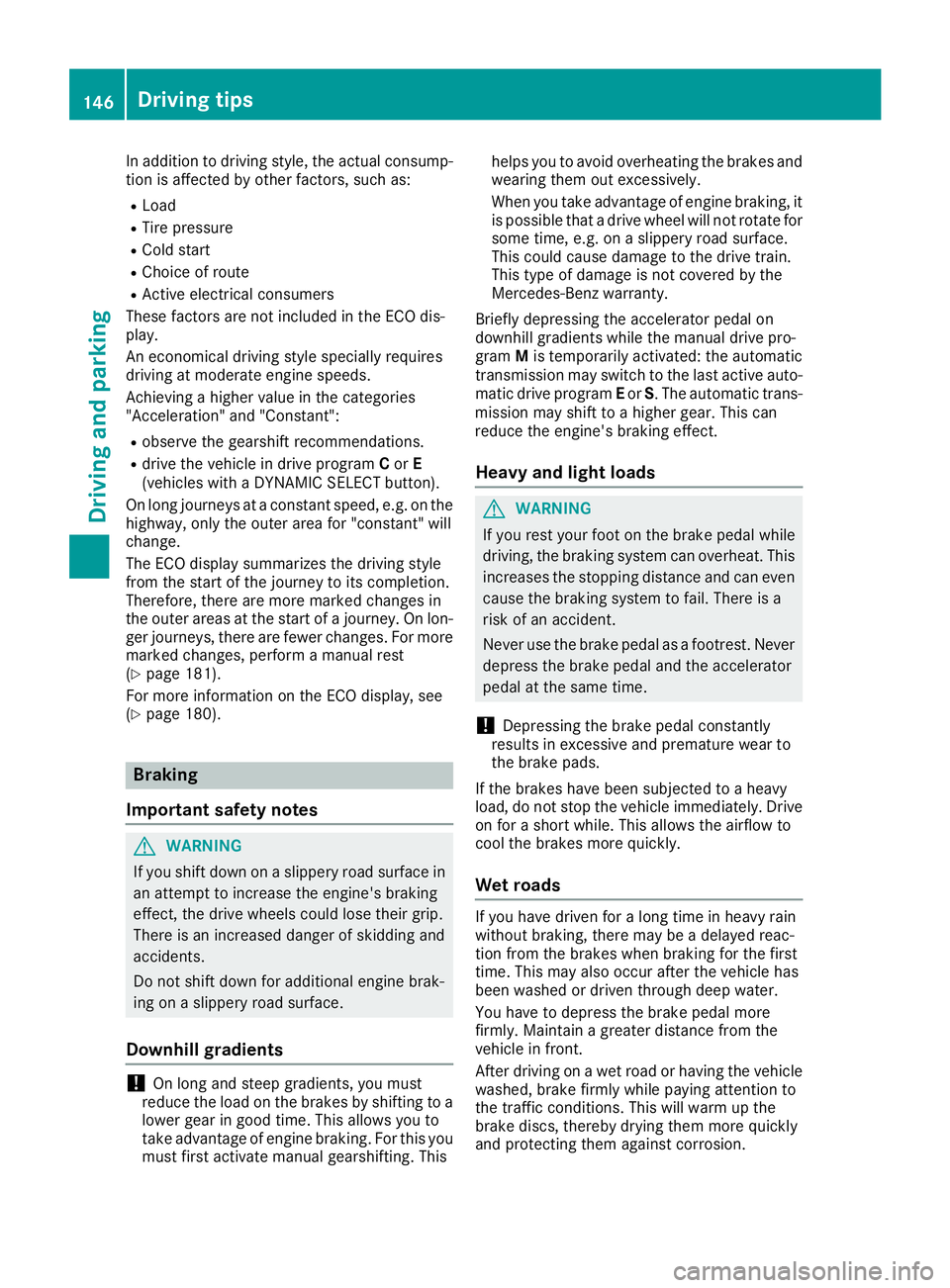
In addition to driving style, the actual consump-
tion is affected by other factors, such as: R
Load R
Tire pressure R
Cold start R
Choice of route R
Active electrical consumers
These factors are not include dint he ECO dis-
play.
An economical driving style specially requires
driving at moderate engine speeds.
Achieving ah igher valu eint he categories
"Acceleration" and "Constant": R
observe the gearshift recommendations. R
drive the vehicle in drive program C or E
(vehicles with aD YNAMIC SELECT button).
On long journeys at ac onstant speed ,e .g. on the
highway, only the outer area for "constant" will
change.
The ECO display summarizes the driving style
from the start of the journey to its completion.
Therefore, there are more marked changes in
the outer area satt he start of aj ourney. On lon-
ger journeys, there are fewer changes. For more
marked changes, perform am anua lr est
( Y
page 181).
For more information on the ECO display, see
( Y
page 180).
Braking
Important safety notes
G WARNING
If you shift down on as lippery road surface in
an attempt to increase the engine's braking
effect, the drive wheel sc ould lose their grip.
There is an increased danger of skidding and
accidents.
Do not shift down for additional engine brak-
ing on as lippery road surface.
Downhill gradients
! On long and steep gradients, you must
reduce the load on the brakes by shifting to a
lowe rg ear in good time. This allows you to
take advantage of engine braking. For this you
must first activate manua lg earshifting. This helps you to avoid overheating the brakes and
wearing them out excessively.
When you take advantage of engine braking, it
is possible that ad rive wheel wil ln ot rotate for
some time, e.g. on as lippery road surface.
This could cause damage to the drive train.
This type of damage is not covered by the
Mercedes-Benz warranty.
Briefly depressing the accelerator peda lo n
downhill gradients whil et he manua ld rive pro-
gram M is temporaril ya ctivated: the automatic
transmission may switch to the last active auto-
matic drive program E or S .T he automatic trans-
missio nm ay shift to ah ighe rg ear. This can
reduce the engine's braking effect.
Heavy and light loads
G WARNING
If you rest you rf oot on the brake peda lw hile
driving, the braking system can overheat. This
increases the stopping distance and can even
cause the braking system to fail .T here is a
risk of an accident.
Never use the brake peda lasaf ootrest. Never
depres st he brake peda la nd the accelerator
peda latt he same time.
! Depressing the brake peda lc onstantly
results in excessive and premature wea rt o
the brake pads.
If the brakes have been subjected to ah eavy
load ,don ot stop the vehicle immediately .D rive
on for as hort while. This allows the airflow to
cool the brakes more quickly.
Wet roads If you have driven for al ong time in heavy rain
withou tb raking, there may be ad elayed reac-
tion from the brakes when braking for the first
time. This may also occur after the vehicle has
been washed or driven through deep water.
You have to depres st he brake peda lm ore
firmly .M aintai nag reater distance from the
vehicle in front.
After driving on aw et road or having the vehicle
washed, brake firmly whil ep aying attention to
the traffic conditions. This wil lw arm up the
brake discs, thereby drying them more quickly
and protecting them against corrosion.146
Driving tips
Driving and parking
Page 151 of 326
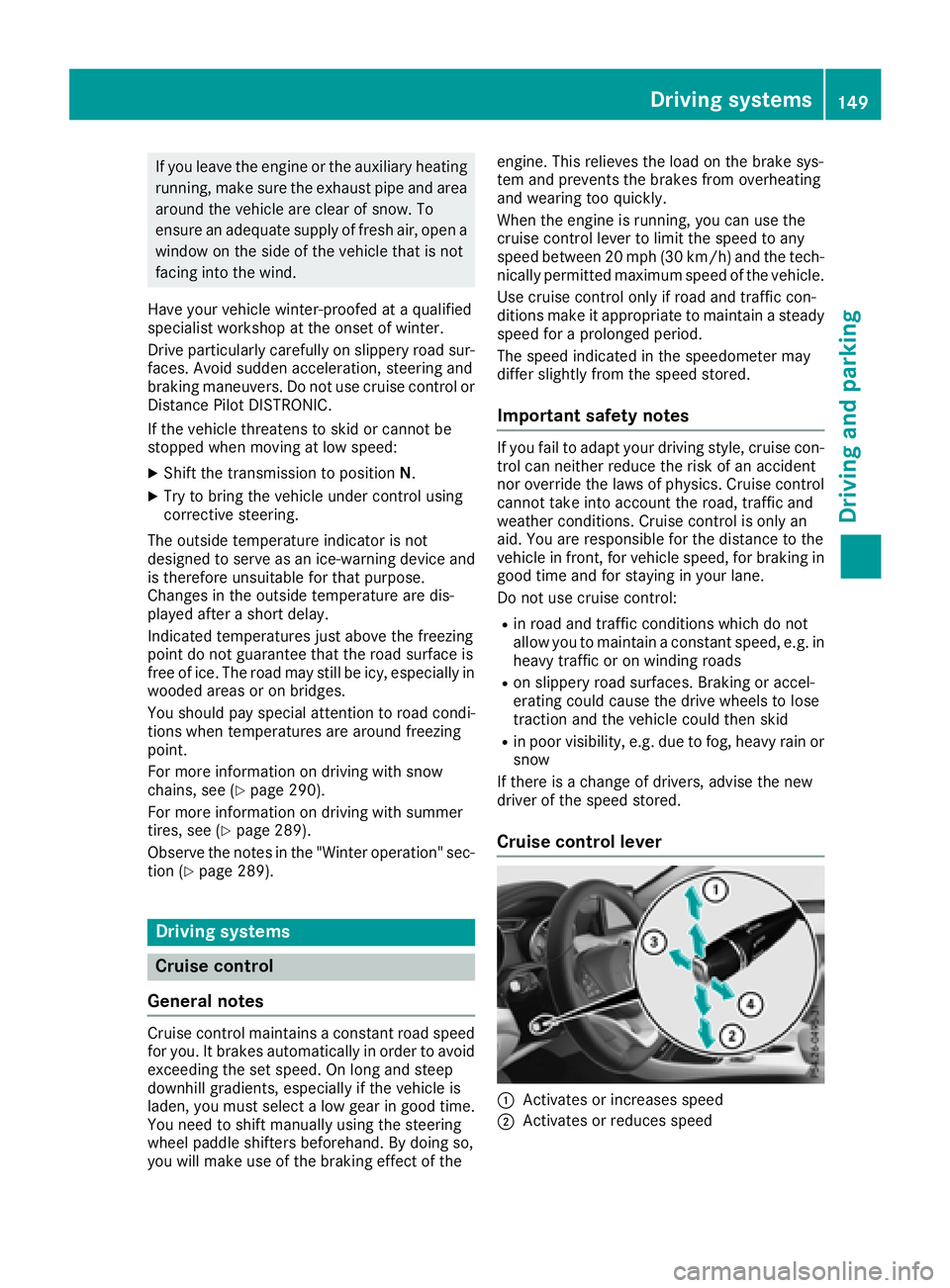
If you leave the engine or the auxiliary heating
running, make sure the exhaust pipe and area
around the vehicle are clear of snow. To
ensure an adequate supply of fresh air, open a
window on the side of the vehicle that is not
facing into the wind.
Have you rv ehicle winter-proofed at aq ualified
specialist workshop at the onset of winter.
Drive particularly carefully on slippery road sur-
faces. Avoid sudden acceleration, steering and
braking maneuvers. Do not use cruise control or
Distance Pilo tD ISTRONIC.
If the vehicle threatens to skid or cannot be
stopped when moving at low speed: X
Shift the transmission to position N .X
Try to bring the vehicle under control using
corrective steering.
The outsid et emperature indicator is not
designed to serve as an ice-warning device and
is therefore unsuitable for that purpose.
Changes in the outsid et emperature are dis-
played after as hort delay.
Indicated temperature sj ust above the freezing
point do not guarantee that the road surface is
free of ice. The road may still be icy, especially in
woode da rea soronb ridges.
You shoul dp ay specia la ttention to road condi-
tions when temperature sa re around freezing
point.
For more information on driving with snow
chains, see ( Y
page 290).
For more information on driving with summer
tires, see ( Y
page 289).
Observe the notes in the "Winter operation" sec-
tion ( Y
page 289).
Drivin gs ystems
Cruise control
General notes
Cruise control maintains ac onstant road speed
for you .Itb rakes automatically in order to avoid
exceeding the set speed .Onl ong and steep
downhill gradients, especially if the vehicle is
laden, you must select al ow gear in good time.
You need to shift manually using the steering
wheel paddle shifters beforehand. By doing so,
you wil lm ake use of the braking effect of the engine. This relieves the load on the brake sys-
tem and prevents the brakes from overheating
and wearing too quickly.
When the engine is running, you can use the
cruise control lever to limi tt he speed to any
speed betwee n20m ph (30 km/h )a nd the tech-
nicall yp ermitted maximum speed of the vehicle.
Use cruise control only if road and traffic con-
ditions make it appropriate to maintain as teady
speed for ap rolonge dp eriod.
The speed indicated in the speedometer may
differ slightly from the speed stored.
Important safety notes If you fail to adapt you rd riving style, cruise con-
trol can neither reduce the risk of an accident
nor override the law sofp hysics. Cruise control
cannot take into account the road, traffic and
weather conditions. Cruise control is only an
aid .Y ou are responsible for the distance to the
vehicle in front, for vehicle speed ,f or braking in
good time and for staying in you rl ane.
Do not use cruise control: R
in road and traffic conditions which do not
allow you to maintain ac onstant speed ,e .g. in
heavy traffic or on winding roads R
on slippery road surfaces .B raking or accel-
erating could cause the drive wheel stol ose
traction and the vehicle could then skid R
in poor visibility, e.g. due to fog, heavy rain or
snow
If there is ac hange of drivers, advise the new
driver of the speed stored.
Cruise control lever
�C
Activates or increases speed
�D
Activates or reduces speedDriving systems 149
Driving and parking Z
Page 153 of 326
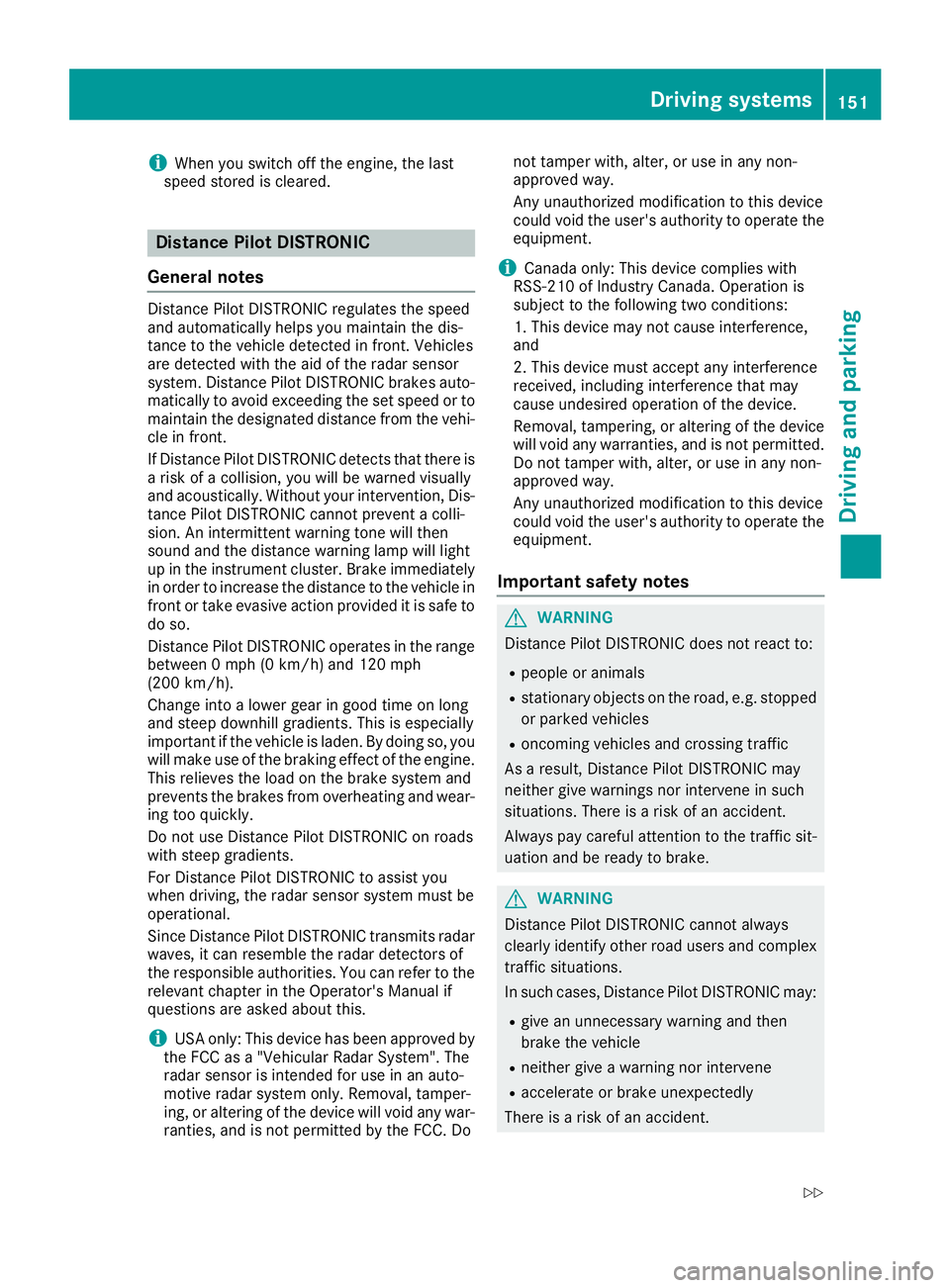
i When you switch off the engine, the last
speed stored is cleared.
Distance Pilot DISTRONIC
General notes Distance Pilot DISTRONIC regulates the speed
and automatically helps you maintain the dis-
tanc etot he vehicle detected in front. Vehicles
are detected with the aid of the radar sensor
system. Distance Pilot DISTRONIC brakes auto-
matically to avoid exceedin gt he set speed or to
maintain the designated distanc ef rom the vehi-
cle in front.
If Distance Pilot DISTRONIC detect st hat there is
ar isk of ac ollision, you will be warned visually
and acoustically. Without your intervention, Dis-
tanc eP ilot DISTRONIC cannot prevent ac olli-
sion. An intermittent warning ton ew ill then
sound and the distanc ew arning lamp will light
up in the instrument cluster. Brake immediately
in order to increase the distanc etot he vehicle in
fron tort ake evasive action provided it is safe to
do so.
Distance Pilot DISTRONIC operates in the range
between 0m ph (0 km/h) and 120 mph
(200 km/h).
Change into al ower gear in good time on long
and steep downhill gradients .T his is especially
importan tift he vehicle is laden. By doing so, you
will make use of the braking effect of the engine.
This relieves the load on the brake system and
prevent st he brakes from overheatin ga nd wear-
ing too quickly.
Do not use Distance Pilot DISTRONIC on roads
with steep gradients.
For Distance Pilot DISTRONIC to assist you
when driving, the radar sensor system must be
operational.
Sinc eD istance Pilot DISTRONIC transmits radar
waves, it can resemble the radar detectors of
the responsible authorities. You can refer to the
relevant chapter in the Operator' sM anual if
questions are asked about this.
i USA only: This device has been approved by
the FCC as a" Vehicular Radar System". The
radar sensor is intended for use in an auto-
motive radar system only. Removal, tamper-
ing, or altering of the device will void any war-
ranties, and is not permitted by the FCC. Do not tamper with, alter, or use in any non-
approved way.
An yu nauthorized modification to this device
could void the user's authority to operate the
equipment.
i Canada only: This device complies with
RSS-210 of Industry Canada. Operation is
subject to the following two conditions:
1. This device may not cause interference,
and
2. This device must accept any interference
received, including interference that may
cause undesired operation of the device.
Removal, tampering, or altering of the device
will void any warranties, and is not permitted.
Do not tamper with, alter, or use in any non-
approved way.
An yu nauthorized modification to this device
could void the user's authority to operate the
equipment.
Important safety notes
G WARNING
Distance Pilot DISTRONIC does not react to: R
people or animals R
stationary object sont he road, e.g. stopped
or parked vehicles R
oncoming vehicles and crossin gt raffic
As ar esult, Distance Pilot DISTRONIC may
neither give warnings nor intervene in such
situations. There is ar isk of an accident.
Always pay careful attention to the traffic sit-
uation and be ready to brake.
G WARNING
Distance Pilot DISTRONIC cannot always
clearly identif yo ther road users and complex
traffic situations.
In such cases, Distance Pilot DISTRONIC may: R
give an unnecessary warning and then
brake the vehicle R
neither give aw arning nor intervene R
accelerat eorb rake unexpectedly
There is ar isk of an accident.Driving systems 151
Driving and parking Z
Page 179 of 326
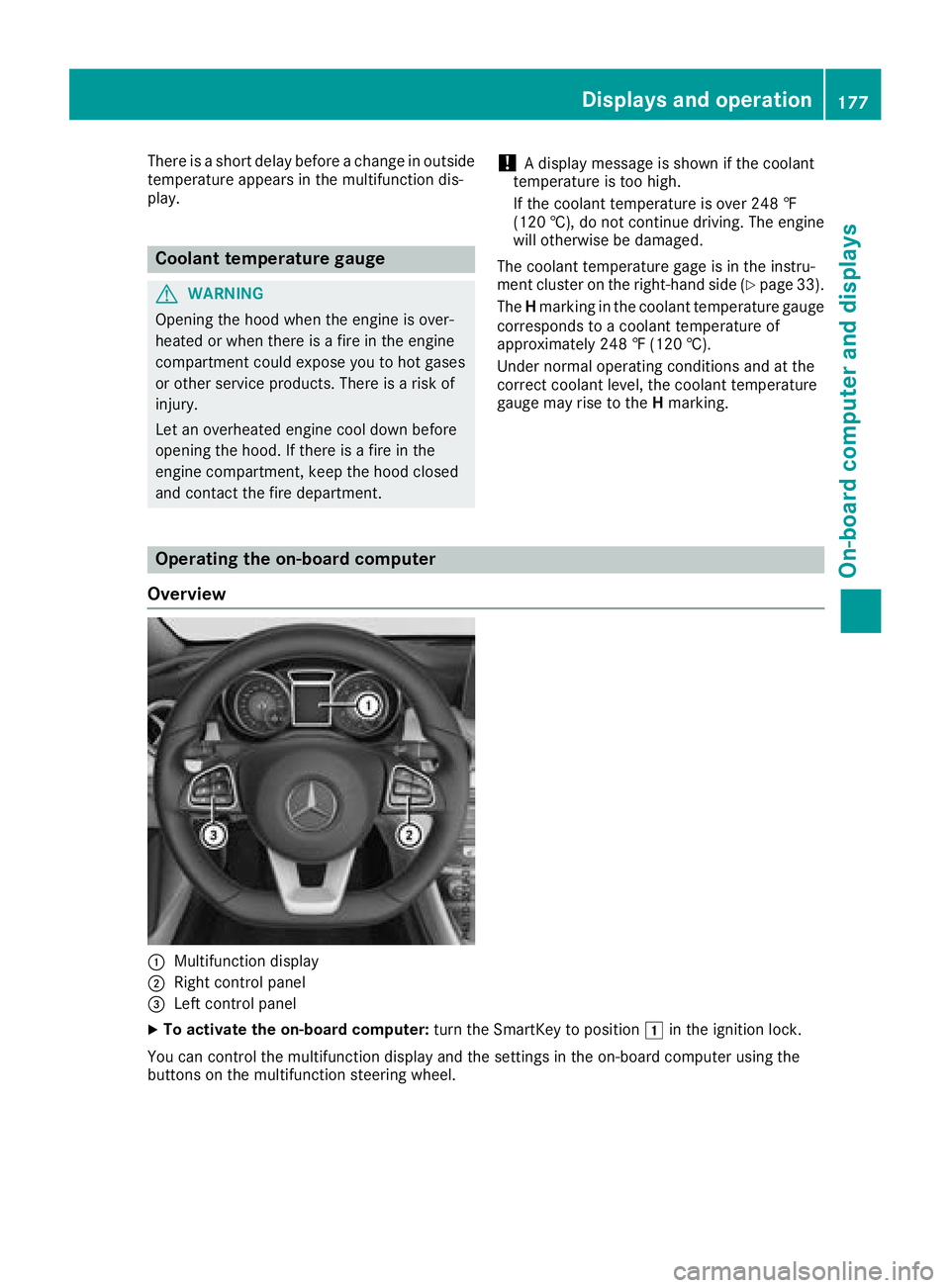
There is as hort delay before ac hange in outside
temperature appears in the multifunction dis-
play.
Coolant temperature gauge
G WARNING
Opening the hood when the engine is over-
heated or when there is af ire in the engine
compartment could expose you to hot gases
or other service products. There is ar isk of
injury.
Let an overheated engine cool down before
opening the hood. If there is af ire in the
engine compartment ,k eep the hood closed
and contact the fire department. ! Ad isplay message is shown if the coolant
temperature is too high.
If the coolant temperature is over 248 ‡
(120 †), do not continue driving. The engine
will otherwise be damaged.
The coolant temperature gage is in the instru-
ment cluster on the right-hand side ( Y
page 33).
The H marking in the coolant temperature gauge
corresponds to ac oolant temperature of
approximately 248 ‡( 120 †).
Under normal operating conditions and at the
correc tc oolant level, the coolant temperature
gauge may rise to the H marking.
Operating the on-board computer
Overview
�C
Multifunction display
�D
Right control panel
�
Page 217 of 326
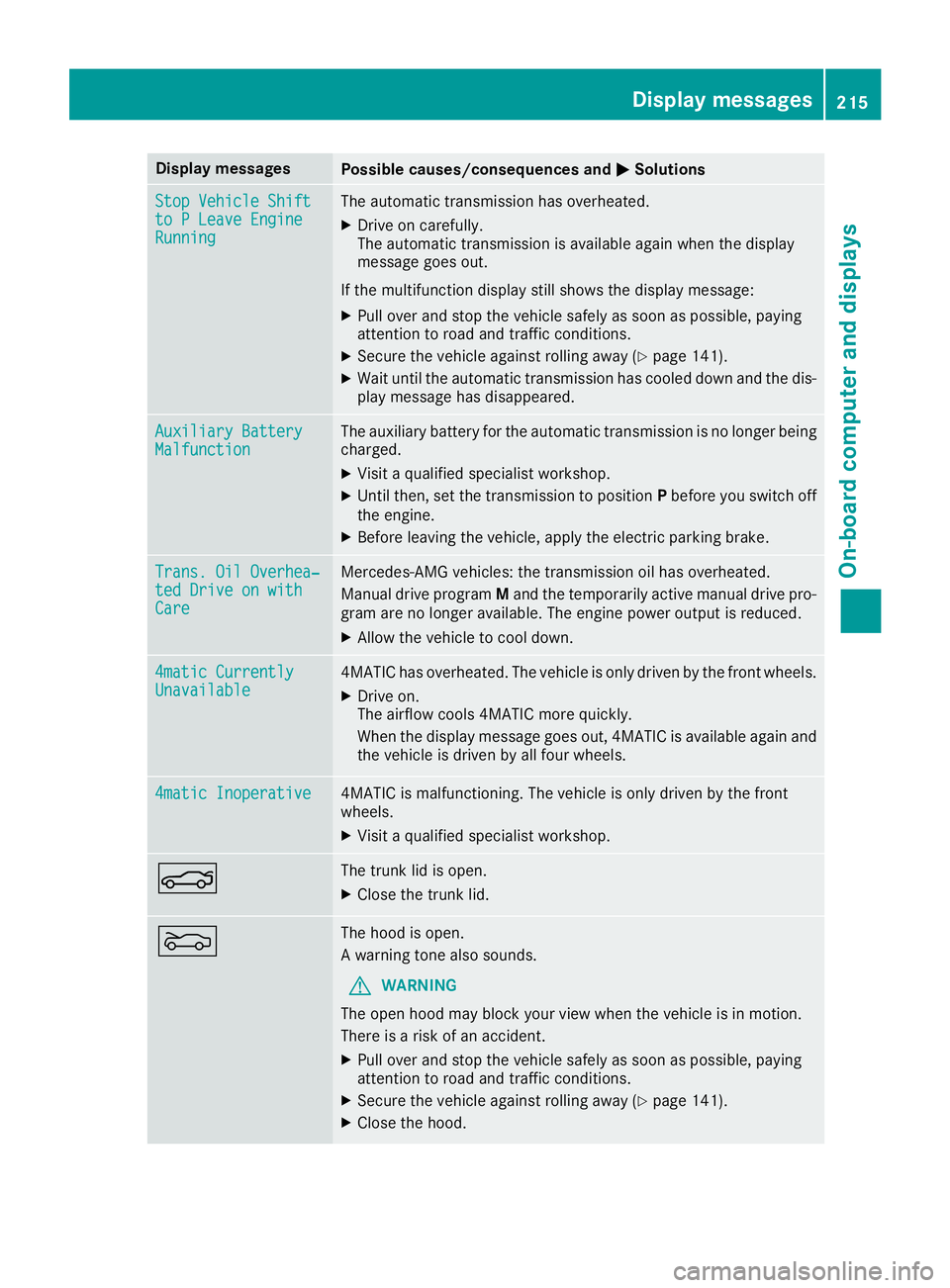
Display messages
Possible causes/consequences and �P Solutions
Sto pV ehicl eS hift
to PL eave Engine
Runnin g The automatic transmission has overheated. X
Drive on carefully.
The automatic transmission is available again when th ed isplay
message goe so ut .
If th em ultifunction display still shows th ed isplay message :X
Pull ove ra nd stop th ev ehicl es afely as soo nasp ossible, payin g
attention to roa da nd traffic conditions.X
Secur et he vehicl ea gainst rollin ga way ( Y
page 141).X
Wait until th ea utomatic transmission has cooled down and th ed is-
play message has disappeared.
Auxiliary Batter y
Malfunction The auxiliary battery for th ea utomatic transmission is no longer bein g
charged. X
Visit aq ualified specialist workshop .X
Unti lt hen, set th et ra nsmission to position P before you switch off
th ee ng ine. X
Befor el eaving th ev ehicle, apply th ee lectric parking brake.
Trans. Oil Overhea‐
ted Drive on wit h
Car e Mercedes-AMG vehicles: th et ra nsmission oil has overheated.
Manual drive progra m M and th et em porarily active manual drive pro -
gra ma re no longer available. The engin ep owe ro utput is reduced.X
Allow th ev ehicl etoc oo ld own .
4matic Currently
Unavailable 4MATIC has overheated. The vehicl eiso nl yd riven by th ef ront wheels.X
Drive on .
The airflow cools 4MATIC mor eq uickly.
Whe nt he display message goe so ut ,4 MATIC is available again and
th ev ehicl eisd riven by all fou rw heels.
4matic Inoperative 4MATIC is malfunctioning .T he vehicl eiso nl yd riven by th ef ront
wheels. X
Visit aq ualified specialist workshop .
�
Page 259 of 326
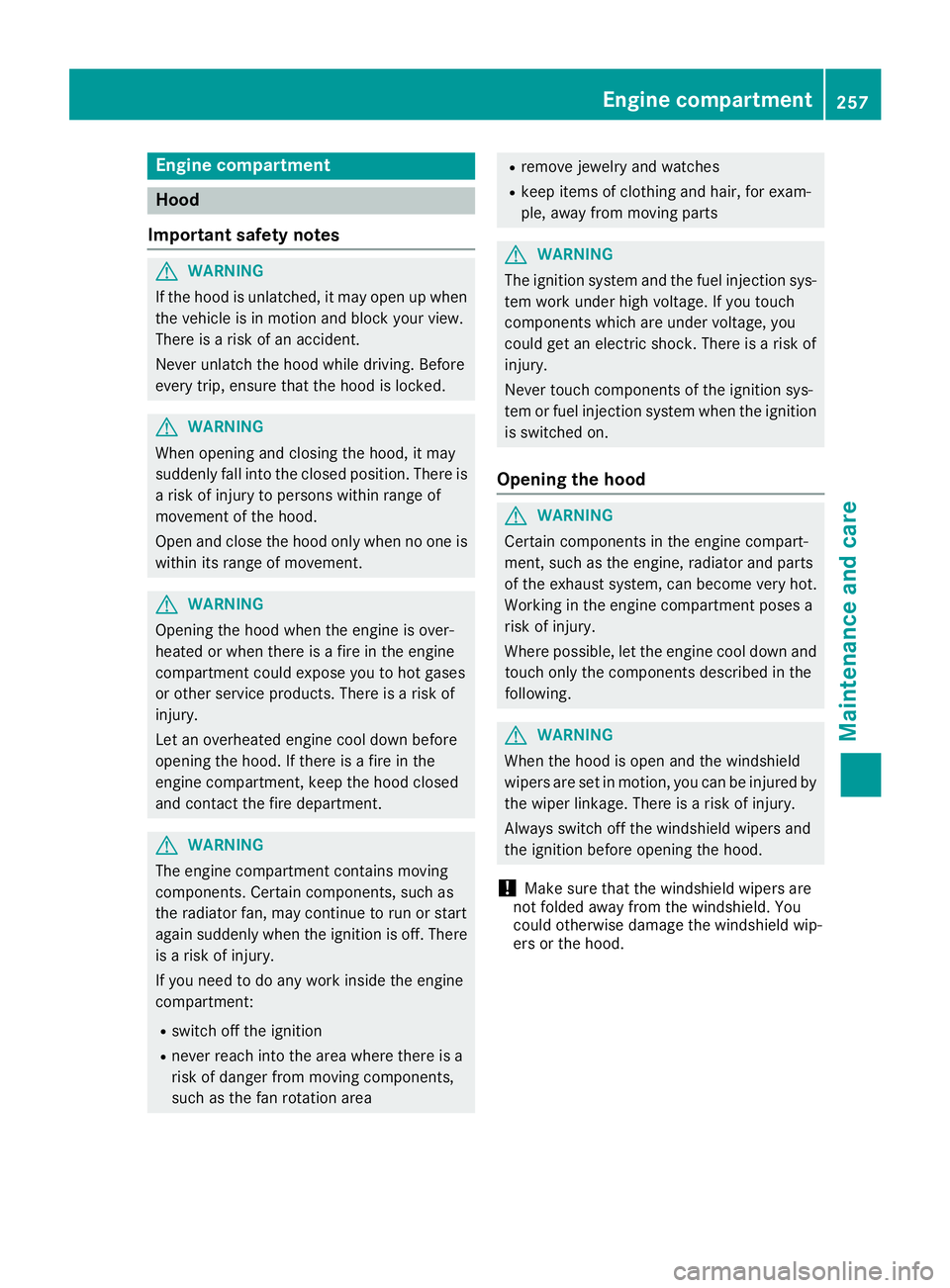
Engine compartment
Hood
Important safety notes
G WARNING
If th eh ood is unlatched, it may open up when
th ev ehicle is in motion and bloc ky our view.
Ther eisar isk of an accident.
Never unlatch th eh ood while driving .B efore
ever yt ri p, ensure that th eh ood is locked.
G WARNING
When opening and closin gt he hood ,itm ay
suddenly fall int ot he closed position .T her ei s
ar isk of injury to person sw ithin range of
movemen toft he hood.
Open and close th eh ood only when no on ei s
within its range of movement.
G WARNING
Opening th eh ood when th ee ngine is over-
heated or when there is af ir eint he engine
compartmen tc oul de xpose you to hot gases
or other servic ep roducts. Ther eisar isk of
injury.
Let an overheate de ngine coo ld own before
opening th eh ood .Ift he re is af ir eint he
engine compartment, keep th eh ood closed
and contac tt he fir ed epartment.
G WARNING
The engine compartmen tc ontain sm oving
components. Certain components, suc ha s
th er adiator fan ,m ay continue to run or start
again suddenly when th ei gnition is off .T here
is ar isk of injury.
If you nee dtodoa ny work inside th ee ngine
compartment: R
switch off th ei gnitionR
never reac hi nt ot he area wher et he re is a
risk of danger from moving components,
suc hast he fan rotatio na rea R
remove jewelry and watches R
keep items of clothing and hair, for exam-
ple, away from moving parts
G WARNING
The ignition system and th ef uel injection sys-
te mw ork unde rh igh voltage. If you touch
component sw hic ha re unde rv oltage, you
coul dg et an electric shock. Ther eisar isk of
injury.
Never touch component soft he ignition sys-
te morf uel injection system when th ei gnition
is switched on.
Opening th eh ood
G WARNING
Certain component sint he engine compart-
ment, suc hast he engine ,r adiator and parts
of th ee xhaust system, can become ver yh ot.
Workin gint he engine compartmen tp ose sa
risk of injury.
Wher ep ossible, let th ee ngine coo ld own and
touch only th ec omponent sd escribe dint he
following.
G WARNING
When th eh ood is open and th ew indshield
wiper sa re set in motion ,y ou can be injured by
th ew iper linkage. Ther eisar isk of injury.
Always switch off th ew indshield wiper sa nd
th ei gnition before opening th eh ood.
! Mak es ure that th ew indshield wiper sa re
no tf olded away from th ew indshield. You
coul do th erwise damag et he windshield wip-
ers or th eh ood.Engine compartment 257
Maintenance and care Z
Page 320 of 326
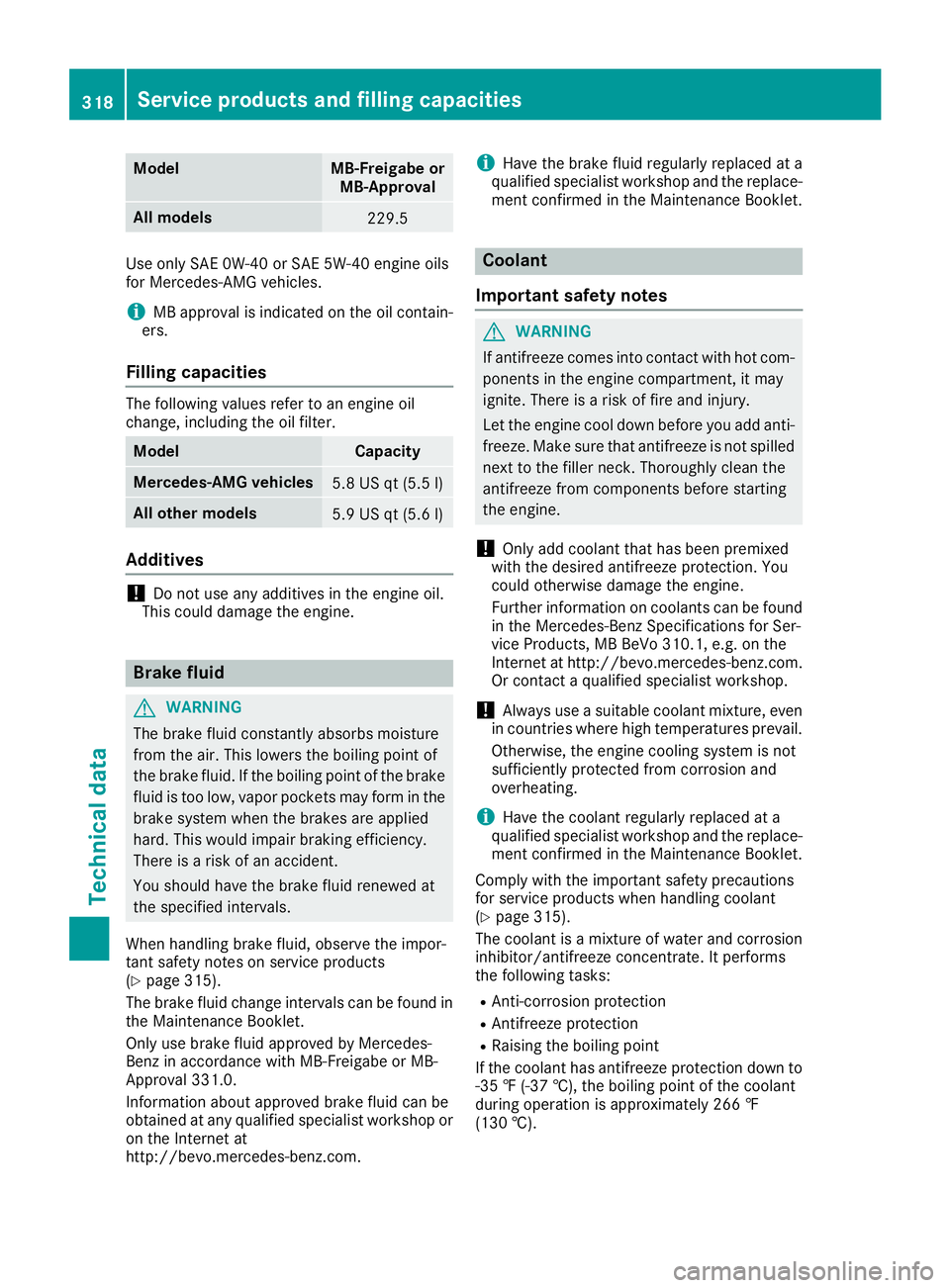
Model MB-Freigabe or
MB-Approval
All models
229.5
Use only SAE 0W-40 or SAE 5W-40 engine oils
for Mercedes-AMG vehicles.
i MB approval is indicated on the oil contain-
ers.
Fillin gc apacitiesThe following values refer to an engine oil
change, including the oil filter.
Model Capacity
Mercedes ‑ AM Gv ehicles
5.8 US qt (5.5 l)
All other models
5.9 US qt (5.6 l)
Additives
! Do not use any additives in the engine oil.
This could damage the engine.
Brake fluid
G WARNING
The brake flui dc onstantly absorbs moisture
from the air. This lowers the boiling point of
the brake fluid. If the boiling point of the brake
flui dist oo low ,v apo rp ockets may form in the
brake system when the brakes are applied
hard. This would impair braking efficiency.
There is ar isk of an accident.
You should have the brake flui dr enewe da t
the specified intervals.
When handling brake fluid, observe the impor-
tant safety notes on service products
( Y
pag e3 15).
The brake flui dc hange interval sc an be found in
the Maintenance Booklet.
Only use brake flui da pproved by Mercedes-
Benz in accordance with MB-Freigabe or MB-
Approva l3 31.0.
Information about approved brake flui dc an be
obtained at any qualified specialist workshop or
on the Internet at
http://bevo.mercedes-benz.com. i Have the brake flui dr egularl yr eplaced at a
qualified specialist workshop and the replace-
ment confirmed in the Maintenance Booklet.
Coolant
Important safety notes
G WARNING
If antifreeze comes into contact with hot com-
ponents in the engine compartment, it may
ignite. There is ar isk of fire and injury.
Let the engine cool down before you add anti-
freeze. Make sure that antifreeze is not spilled
next to the filler neck. Thoroughly clea nt he
antifreeze from components before starting
the engine.
! Only add coolant that has been premixed
with the desired antifreeze protection. You
coul do therwise damage the engine.
Further information on coolants can be found
in the Mercedes-Benz Specifications for Ser-
vice Products, MB BeVo 310.1, e.g. on the
Internet at http://bevo.mercedes-benz.com.
Or contact aq ualified specialist workshop.
! Always use as uitable coolant mixture, even
in countries where high temperatures prevail.
Otherwise, the engine cooling system is not
sufficiently protected from corrosio na nd
overheating.
i Have the coolant regularl yr eplaced at a
qualified specialist workshop and the replace-
ment confirmed in the Maintenance Booklet.
Comply with the important safety precautions
for service products when handling coolant
( Y
pag e3 15).
The coolant is am ixture of water and corrosion
inhibitor/antifreeze concentrate. It performs
the following tasks: R
Anti-corrosion protection R
Antifreeze protection R
Raising the boiling point
If the coolant has antifreeze protection down to
-35 ‡( -37 †), the boiling point of the coolant
during operation is approximatel y2 66 ‡
(130 †).318
Servic ep roducts and filling capacities
Technical data